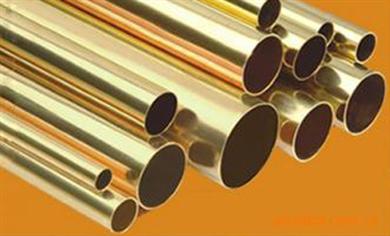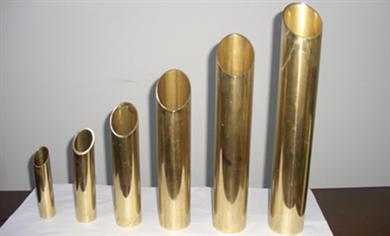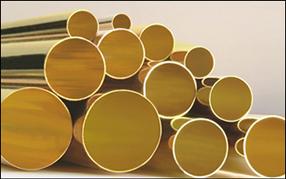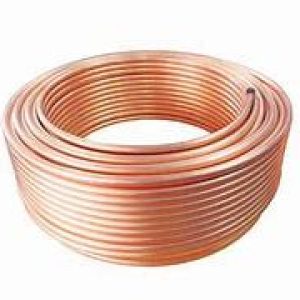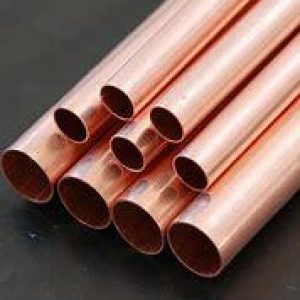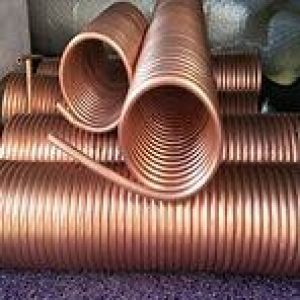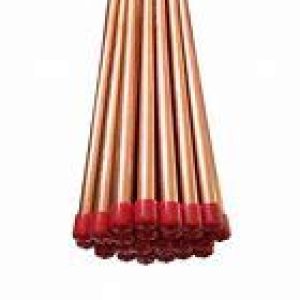Brass Pipe Overview
Brass pipe can be divided into copper pipes for electrical appliances, copper pipes for refrigeration, high-pressure resistant copper pipes, corrosion-resistant copper pipes, copper pipes for connections, copper pipes for waterways, electric heating copper pipes, and industrial copper pipes.
Brass Pipe Performance
Seamless copper tubes drawn from brass have strong wear resistance, light weight, good thermal conductivity, and high low-temperature strength. The copper tubes are hard in texture, not easy to corrode, and resistant to high temperatures and high pressures. They can be used in a variety of non-copper types. environment.
Brass Pipe Features
Mechanical properties
| Grade | Status | Round | Rectangular (Square) | ||
| Outside | Wall thickness | Margins | Wall thickness | ||
| H96、H90 | Soft (M), light-soft (M2), semi-hard (Y2), hard (Y) | 3~2000 | 0.2~10 | 3~100 | 0.2~7 |
| H85、H80、H85A | |||||
| H70、H68、H59、HPb59-1、 HSn62-1、HSn70-1、H70A、H68A | 3~100 | ||||
| H65、H63、H62、HPb66-0.5、H65A | 3~200 | ||||
| HPb63-0.1 | Semi-hard (Y2) | 18~31 | 6.5~13 | —— | —— |
| 1/3 hard (Y3) | 8~31 | 3.0~13 | |||
(Those with an outer diameter of less than 3 mm are capillary tubes and will not be repeated here.)
(The following are only the mainstream products in the market. If you need anything else, you can leave me a message and add more.)
Mechanical properties
| Grade | Status | Stretching test | Hardness test | ||
| Tensile strength Rm / MPa not less than | Elongation A / % not less than | Vickers hardnessa / HV | Brinell hardness b / HB | ||
| H68 | M | 280 | 43 | 55~85 | 50~80 |
| M2 | 350 | 40 | 85~120 | 80~115 | |
| Y2 | 370 | 25 | 95~125 | 90~120 | |
| Y | 420 | — | ≥115 | ≥110 | |
| H65 | M | 290 | 43 | 55~85 | 50~80 |
| M2 | 360 | 25 | 80~115 | 75~110 | |
| Y2 | 370 | 18 | 90~120 | 85~115 | |
| Y | 430 | — | ≥110 | ≥105 | |
| H63、 H62 | M | 300 | 43 | 60~90 | 55~85 |
| M2 | 360 | 25 | 75~110 | 70~105 | |
| Y2 | 370 | 18 | 85~120 | 80~115 | |
| Y | 440 | — | ≥115 | ≥110 | |
Chemical composition
| Grade | Chemical Composition(%) | |||||||||
| Name | Code name | Cu | Fe | Pb | Al | Mn | Sn | Ni | Zn | Total Impurities |
| 68 Brass (tube) | H68 | 67.0~70.0 | 0.10 | 0.03 | — | — | — | 0.5 | Margin | 0.3 |
| 65 Brass (tube)) | H65 | 63.5~68.0 | 0.10 | 0.03 | — | — | — | 0.5 | Margin | 0.3 |
| 63 Brass (tube) | H63 | 62.0~65.0 | 0.15 | 0.08 | — | — | — | 0.5 | Margin | 0.5 |
| 62 Brass (tube) | H62 | 60.5~63.5 | 0.15 | 0.08 | — | — | — | 0.5 | Margin | 0.5 |
Brass Pipe Specification
| Alloy grade | State | Section size | length | Guideline | |
| Outer diameter | Wall thickness | ||||
| H96 | R | φ60~280 | 5~42.5 | 500~6000 | GB/T1528-1997 |
| M Y | φ15~200 | 0.75~10 | 500~7000 | GB/T1527-1997 | |
| H68 | Y | φ15~30 | 0.75~0.90 | 500~7000 | GB/T1527-1997 |
| M Y2 | φ15~60 | 0.75~10 | |||
| H65 | Y2 | φ25~42 | 2.3~3 | 2000~4000 | Corporate standards |
| H62 | R | φ60~280 | 5~42.5 | 500~6000 | GB/T1528-1997 |
| φ135~140 | 45 | 300~2000 | Corporate standards | ||
| φ145~200 | 45~50 | 300~2000 | |||
| φ205~260 | 45~50 | 300~1500 | |||
| φ265~300 | 45~50 | 300~1000 | |||
| Y | φ15~30 | 0.75~0.90 | 500~7000 | GB/T1527-1997 | |
| M Y2 | φ15~200 | 0.75~10 | |||
| M Y2 | φ40~200 | 10.5~17.5 | 500~7000 | Corporate standards | |
| φ201~280 | 4~17.5 | ||||
| H68A H85A | M Y2 | φ10~45 | 0.75~3.5 | 2000~15000 | GB/T8890-1998 |
| HAl77-2 (C68700) | M Y2 | φ10~45 | 0.75~3.5 | 2000~15000 | GB/T8890-1998 |
| HSn70-1 (C44300) | M Y2 | φ15~60 | 0.75~10 | 500~7000 | GB/T1527-1997 |
| φ10~45 | 0.75~3.5 | 2000~15000 | GB/T8890-1998 | ||
| HSn70-1B HSn70-1AB | Y2 | φ10~35 | 0.75~3.0 | 2000~18000 | Corporate standards |
| HSn62-1 | M Y2 | φ15~60 | 0.75~10 | 500~7000 | GB/T1527-1997 |
| C23000 | H58 O61 | φ10.29~114.30 | 1.57~6.35 | ≤6096 | Corporate standards ASTMB43 |
| O60 | φ10~180 | 0.9~3 | 3658 | ||
| HFe59-1-1 | R | φ60~280 | 5~42.5 | 500~6000 | GB/T1528-1997 |
| H59-1 | R | φ60~280 | 5~42.5 | 500~6000 | GB/T1528-1997 |
| φ135~140 | 45 | 300~2000 | Corporate standards | ||
| φ145~200 | 45~50 </< td> | ||||
Brass Pipe Application
In the aerospace field, copper tubes are mainly used as heaters on aircraft engines and other mechanical equipment. Their high thermal conductivity enables them to better protect the normal operation of machinery and equipment in high-temperature and high-pressure environments.
In the chemical industry, copper tubes are mainly used to manufacture chemical equipment, petrochemical equipment, and related accessories. Copper pipes’ superior corrosion resistance can effectively prevent the corrosion of chemical products on the pipes.
In the construction field, copper tubes are widely used to make pipes and fittings for heating, ventilation, cooling and air conditioning systems. It has excellent thermal conductivity and can quickly transfer heat, allowing heating systems, air conditioning systems, etc. to operate efficiently. At the same time, copper tubes also have excellent corrosion resistance. They are not easily affected by the environment and water quality during long-term use, helping to improve the stability and reliability of building systems.
In the electronics field, copper tubes are used to make cables that connect sensors, as well as to make solar panels, LED lights, and other electronic lighting equipment. In addition, copper tubes are widely used in the manufacturing of semiconductor appliances and high-precision instruments because of their good electrical conductivity and reliable corrosion resistance.
Company Profile
Copper Channel is a trusted global chemical material supplier & manufacturer with over 12-year-experience in providing super high-quality copper and relatives products.
The company has a professional technical department and Quality Supervision Department, a well-equipped laboratory, and equipped with advanced testing equipment and after-sales customer service center.
If you are looking for high-quality copper products, please feel free to contact us or click on the needed products to send an inquiry.
Payment Methods of Brass Pipe
L/C, T/T, Western Union, Paypal, Credit Card etc.
Shipment of Brass Pipe
It could be shipped by sea, by air, or by reveal ASAP as soon as repayment receipt.
FAQ
What are the advantages of copper tubes compared to other metal tubes?
Answer: Copper tubes have excellent thermal conductivity and corrosion resistance, and are easy to process and install. In addition, copper tubes also have a long service life and good environmental performance.
What should we pay attention to during the installation process of copper pipes?
Answer: When installing copper pipes, you need to pay attention to the bending radius, support and fixation methods of the pipes, as well as the sealing and tightening of the joints. Avoid excessive bending or flattening of pipes to ensure quality installation.
How to maintain copper tubes during use?
Answer: Copper tubes should be inspected regularly during use to detect and deal with possible corrosion, leakage or blockage problems in a timely manner. For exposed parts, protective measures such as applying anti-rust coatings can be taken.
What is the price of copper tubes?
Answer: The price of copper tubes is affected by many factors such as market supply and demand, copper price and processing cost, so the price will fluctuate. Generally speaking, the price of copper tubes is relatively high, but its excellent performance and long life make it highly cost-effective.
Are copper tubes prone to oxidation and corrosion?
Answer: Copper pipes are indeed susceptible to oxidative corrosion in humid environments, but they can be protected by applying anti-rust coatings or using gas-phase rust inhibitors. In addition, choosing good quality copper pipes and proper installation techniques can also reduce the risk of oxidation corrosion.
What should you pay attention to when welding copper tubes?
Answer: When welding copper pipes, you need to choose the appropriate welding process and materials, control the welding temperature and speed, and ensure the quality and sealing of the weld. At the same time, welding personnel need to have certain professional skills and experience to ensure welding quality.
How to deal with the bending and deformation of copper tube?
Answer: The copper tube may be bent and deformed during processing or installation. For slight deformation, it can be processed through heating correction or mechanical correction; for severe deformation, it may be necessary to replace the copper tube with a new one.
